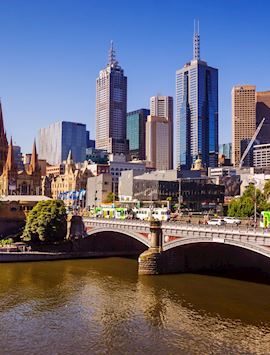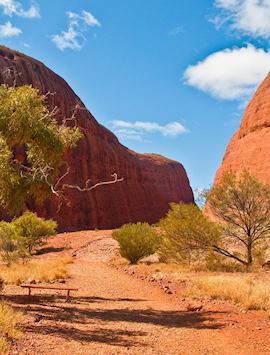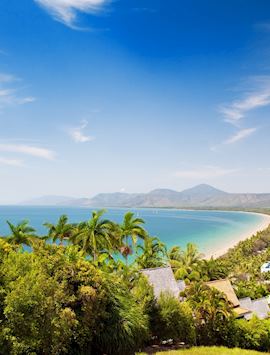Offering a heady mix of world-class vineyards, historic goldfields, cosmopolitan cityscapes, and white-sand beaches, as well as Australia’s finest road trip, Victoria makes for an exciting visit at any time of year.
From navigating Melbourne’s street-art-clad artilleries with a private guide to taking a paddle steamer down the bucolic Murray River, there are a multitude of ways you can take in Victoria’s highlights. Here are a few of our best-loved things to see and do.
Select your experience:
1. Coffee & culture in Melbourne’s CBD
2. Outdoor pursuits at Melbourne’s stadiums, parks & beaches
3. Local life in Melbourne’s suburbs & Geelong
4. Wine tastings & hot-air balloon rides in the Yarra Valley
5. Sky-high forests & tranquil towns in the Dandenong Ranges
6. A road trip around the Mornington Peninsula
7. Hot springs & gold rush history in Daylesford & the Goldfields
Melbourne & Central Victoria
By Australia specialist Devin
1. Coffee & culture in Melbourne’s CBD
Melbourne is the definition of eclectic. It’s historic yet fastidiously up to date. It can’t stand still, yet it beckons you to take it all in at a slower pace. The whole city is a mosaic of multifaceted cultures, which you have to embrace fully to really feel how it ticks.
Ask any Australian what Melbourne’s most famous cultural export is, and they’ll say coffee. Café culture is deeply ingrained in the zeitgeist here, so much so that the Melburnians invented their own beverage, the magic (a smaller, stronger take on the flat white).
You can sample a magic at any one of the many coffee shops that pepper Melbourne’s CBD (central business district), but to truly get a sense of the atmosphere, I suggest taking a tour around its laneways and arcades. Moving between art-filled alleys (Hosier Lane), Italianate shopping precincts (Royal Arcade), and tiny artilleries packed with alfresco diners (Degraves Street), you’ll soon get an idea of how this patchwork city developed.
Now fully caffeinated, I encourage you to catch the tram (they’re free within the CBD) to explore some of the city’s grand architecture. Melbourne’s more European in design than most other cities its age — and deliberately so. You can see the vast wealth of the gold rush in the spires of St Paul’s Cathedral and green copper domes of Flinders Street Station, but my favourite spot is State Library Victoria with its enormous, ornate reading room.
Like all cosmopolitan cities, Melbourne has its pick of museums too. To delve further into its past, head to Melbourne Museum or the Immigration Museum. To see Australian artworks, including Aboriginal pieces, stop by the Ian Potter Centre on the avant-garde-designed Federation Square. I was also blown away by the displays, from original zoetropes to Mad Max props, found at ACMI, Australia's national museum of cinema and digital arts.
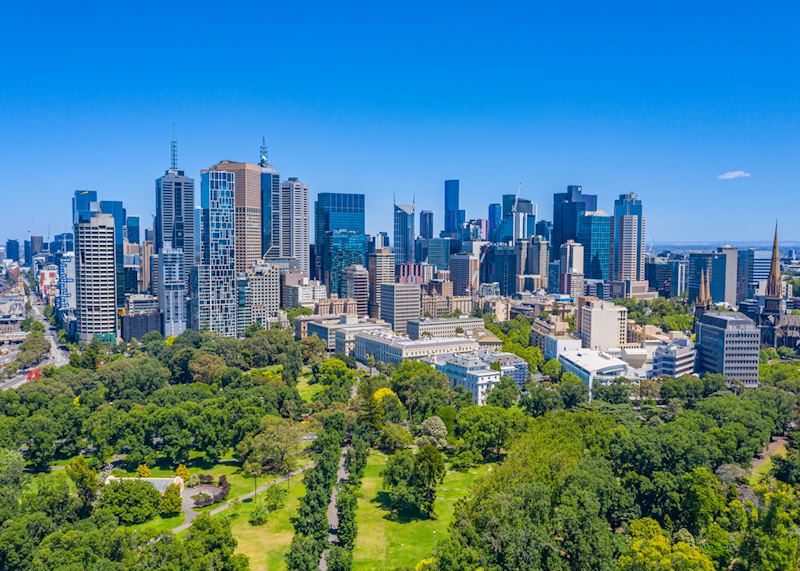
2. Outdoor pursuits at Melbourne’s stadiums, parks & beaches
Whether they’re enjoying a moonlit kayak down the Yarra River, watching tennis at the Australian Open, or sipping aromatic cocktails at a swanky rooftop bar, Melburnians are almost always outdoors. I can help you get a taste of this culture on a tour based around your particular interests.
Sports are a way of life here, so you might choose to go behind the scenes at one of the many venues scattered in and around the city, such as the MCG (Melbourne Cricket Ground, the largest stadium in the Southern Hemisphere) or Rod Laver Arena (home to the Australian Open).
Season depending, you could catch some of the events yourself, such as the Australian Grand Prix, Lions rugby tour, The Ashes, and the Australian Open. If you’re feeling particularly adventurous, you might even attend an AFL (Australian Football League) match at Marvel Stadium or the MCG.
Beaches are another great way to soak up some vitamin D in Melbourne. St Kilda, the best-known seaside suburb, might be a little tattered around the edges nowadays, but it’s still worth a stop for its quirky cake shops, carnivalesque Luna Park, and the pier, where you can often spot little penguins. Brighton Beach, with its vibrantly painted bathing boxes, is a better option for sunbathing, or you could venture further out to the secluded Half Moon Bay.
The city benefits from many green spaces too, like the resplendent Royal Botanic Gardens, which hosts an open-air movie experience from December to April. But don’t discount the built-up areas. One of the best activities in Melbourne is taking a sunset kayak through the heart of the city, or the more sports-averse can head to one of the many terrace bars, like Rooftop at QT, for a cocktail amid the skyscrapers.
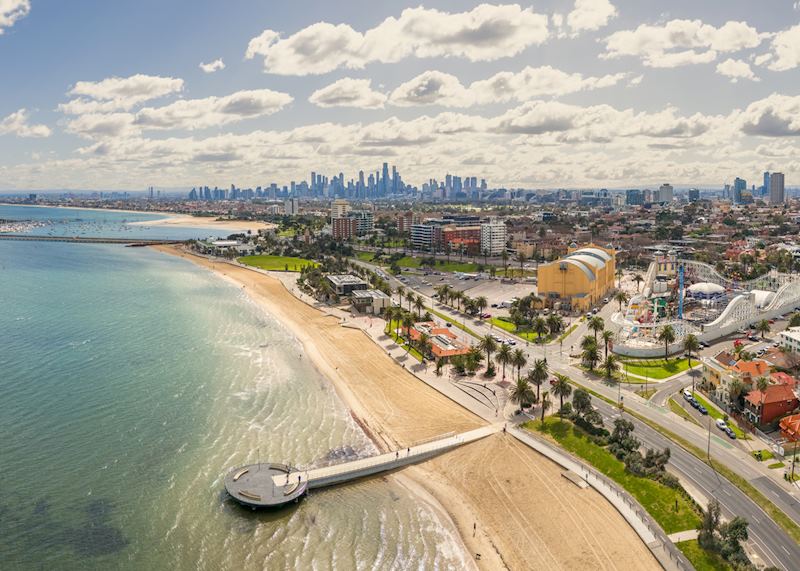
3. Local life in Melbourne’s suburbs & Geelong
To properly experience Melbourne, you must venture further out than the CBD and see some of its suburbs.
I have a real appreciation for the inner-northern districts: gritty Collingwood, bohemian Fitzroy, academic Carlton, and multicultural Brunswick. They’ve all got their own flair, but in each you’ll find bustling streets full of independent bookstores, artsy record shops, hip cafés, and in-vogue restaurants. It’s the sort of area where Victorian-era terraces with iron lacework sit cheek-by-jowl with converted warehouses. Only got time to visit one? Head to Lygon Street in Carlton — Melbourne’s answer to Little Italy. It’s not far from historic Queen Victoria Market, where you can grab some hearty street food.
Further south, you’ll find the glitzier areas like Southbank, Docklands, and Port Melbourne, where you can enjoy some of the city’s best waterfront restaurants and galleries. Then there’s Williamstown in the southwest, with its excellent skyline views and 19th-century seaport. And Abbotsford in the northeast is the home of Abbotsford Convent, a heritage building with extensive gardens and an arts precinct.
Alternatively, a little further along the map is Geelong, Victoria’s second-largest city. This once-industrial town is now quickly becoming a creative hub, but I’m biased toward its sparkling waterfront and Art Deco façade. It’s also a gateway to the boutique wineries and beaches of the Bellarine Peninsula.

4. Wine tastings & hot-air balloon rides in the Yarra Valley
About an hour’s drive northeast of Melbourne sits the rolling hills and neatly manicured vineyards of the Yarra Valley. Touted as Victoria’s premier wine region, it’s the place to be to try some of Australia’s finest cool-climate wines, including silky pinot noirs and oaky chardonnays.
With over 160 wineries to choose from, there’s plenty of opportunities to sample the valley’s varietals. I’m a huge fan of Chandon, the Australian outpost of champagne house Moët & Chandon. During a private tasting at their glitzy cellar door, you’re guided through the artistry of the house’s blending process. You also sample four of their sparkling wines, each paired with a local cheese and canapé.
Aside from Chandon, you might try the award-winning dessert wines at De Bortoli or visit TarraWarra, where the cellar door has been carved into the hillside like a hobbit home. Beyond wine, there’s Four Pillars gin distillery, an ex-industrial warehouse in the artsy town of Healesville. Opt for their G&T paddle to make the most of your tastings — I recommend the Bloody Shiraz option, which combines their classic dry gin with Yarra Valley grapes.
You can stay in the valley for a few days, soaking up the scenery, or I can arrange for you a private tour tailored to your interests from Melbourne. For some extra romance, I suggest taking a hot-air balloon over the vineyards at sunrise, a glass of local sparkling wine in hand.

5. Sky-high forests & tranquil towns in the Dandenong Ranges
Charming mountain towns replete with witchy shops. Mimicking lyrebirds sitting on fluffy ferns. Tooting steam trains that wind through old-growth forests. The Dandenong Ranges are my go-to spot for a dose of tranquillity away from the city.
For a family-friendly vantage point of the area, take the Puffing Billy steam train from Belgrave. Legs dangling from an open-sided carriage, you’ll pass through towering forests of mountain ash (the world’s largest flowering plant) before disembarking at Lakeside Railway Station. It’s worth bringing a high-quality camera on board — the pièce de resistance of this journey is the crossing over Monbulk Creek Trestle Bridge, a lanky viaduct worthy of an old Western.
Beyond the railway experience, there’s a wealth of hiking trails to explore by foot. The best-known trail, the Kokoda Memorial Walk (otherwise known as “1000 steps”) commemorates a significant campaign in Australian military history. It’s a challenging trek through lush fern gullies, and the memorial plaques en route serve as a living lesson on World War II.
Elsewhere, I like the Sherbrooke and Olinda Falls loops, which culminate in cascading waterfalls that are especially impressive after rainfall. Flamboyant lyrebirds, known for their ornate tails and excellent mimicry skills, are a fairly common sight.
With streets chock-full of bohemian shops and confectioners, the towns of Olinda, Sassafras, and Belgrave serve as great places to relax in the ranges. I’m drawn to Sassafras for its Agatha Christie-themed afternoon tea at Miss Marple’s Tea Room. Or, to see some impeccably maintained rhododendrons, head to Dandenong Ranges Botanic Gardens in Olinda.
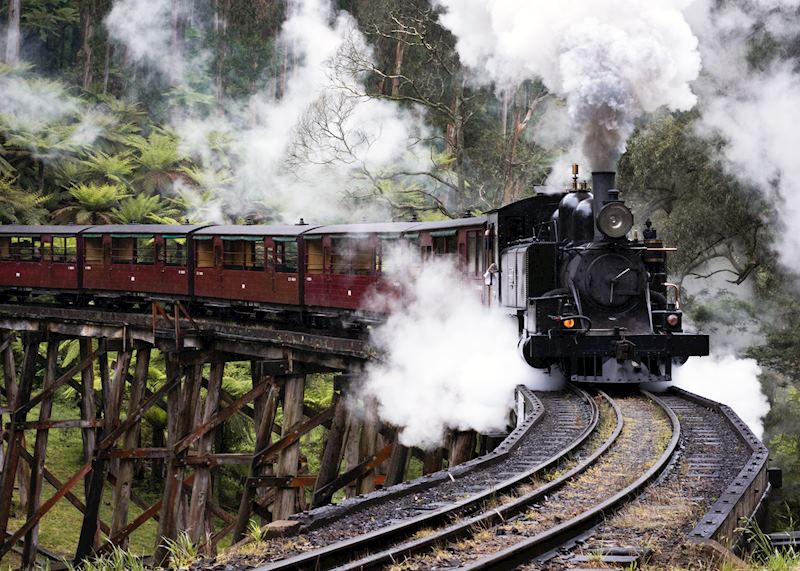
6. A road trip around the Mornington Peninsula
Quaint coastal towns, an artisanal food scene, soothing hot springs, and wild surf beaches… These are just some of the reasons why the Mornington Peninsula is the Melburnians’ preferred weekend playground. I can put together a one-day tour of the area based entirely around your interests, or you could choose to go it alone on a road trip around the coast.
If you opt for the latter, I’d start in the namesake town of Mornington. Here, you’ll find contemporary cafés to rival even hipster Melbourne, and a 10-minute drive west takes you to Mount Martha Beach, home to a line of brightly painted bathing boxes (beach huts).
Further along, you’ll reach Sorrento and its historic limestone buildings. It’s an ideal base for exploring Point Nepean, a narrow bar at the peninsula’s tip with a whole host of walking trails looking out onto the Bass Strait’s furious seas.
More wind-whipped shorelines dot the south of the peninsula, including Cape Schanck, where you might watch the foamy surf from atop a classic whitewashed lighthouse. But, for something more relaxing, consider Peninsula Hot Springs in Fingal, and spend a day bathing in natural geothermal pools.
Finish your trip in Red Hill, celebrated for its sophisticated culinary scene. I can’t recommend enough a wine tasting at Montalto Winery, or you could visit from Thursday to Saturday to buy local produce at the weekly market. You can also take the gondola up to Arthurs Seat and gaze upon a panorama that encompasses both Melbourne and the peninsula itself.
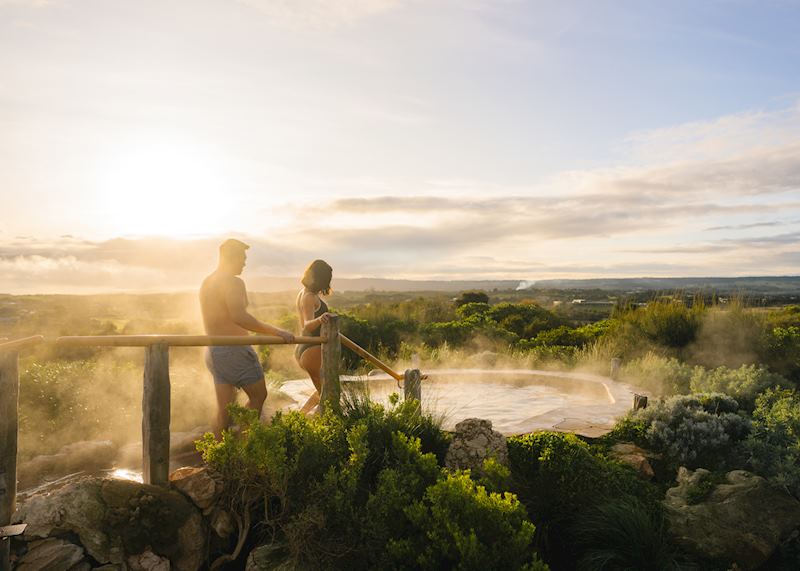
Western Victoria
By Australia specialist Charlotte
7. Hot springs & gold rush history in Daylesford & the Goldfields
Victoria was the heart of Australia’s gold rush. In the 1850s, more than a third of the world’s gold was mined here. That era might be far behind now, but its legacies — grand neoclassical buildings, Victorian-era bathhouses, and still-extant goldfields — live on in the areas of Daylesford and the Goldfields.
Today, as in the 19th century, Daylesford is Australia’s undisputed spa capital. I’d point you to Hepburn Spa Retreat, just north of the town, for a hot-spring experience that hearkens back to the Victorian era. You’ll likely also want to wander the town itself, where you’ll find filigreed buildings housing modern cafés and shops. It’s worth renting a boat to explore Lake Daylesford, or you can pass the time admiring frescoes at the re-purposed Convent Gallery.
Nearby, the Macedon Ranges are another option if you want to delve deeper into eucalypt-clad mountains, family-run wineries, and bluestone-built towns. Some highlights of the area include the wild west feel of Kyneton’s Piper Street and the alfresco tastings at Gisborne Peak Winery.
To the north and west of this area, sits the Goldfields, with the largest city being Ballarat. A thriving boomtown during the gold rush years (and the location of one of Australia’s most pivotal rebellions), Ballarat is rich in ornate Italianate and neo-Gothic architecture. It’s also the location of Sovereign Hill, a family-friendly open-air museum that recreates life in the goldfields.
An hour’s drive north, lies equally historic Bendigo, where you can take an underground tour of the Central Deborah Gold Mine.
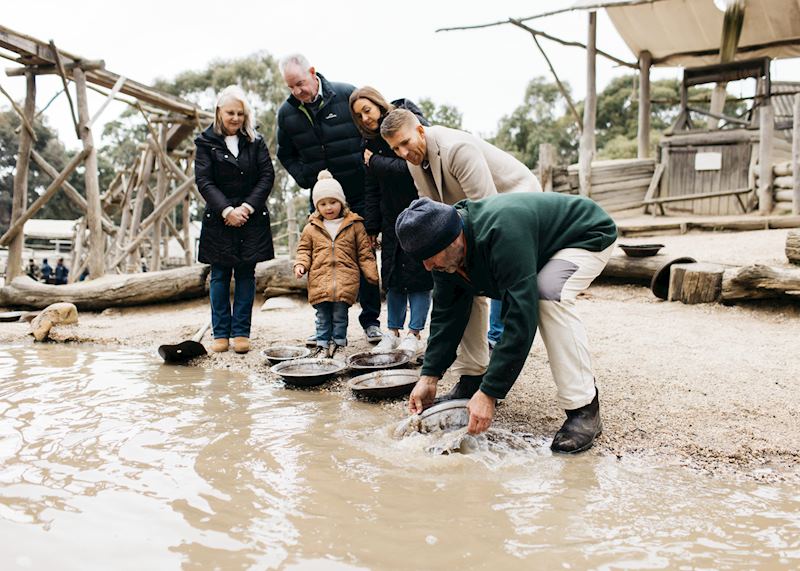
8. Iconic landmarks along the Great Ocean Road
The Great Ocean Road is legendary. Winding between world-class beaches, sheer-faced sea stacks, and pockets of rainforest, it’s rightly considered one of the best road trips in the world. And there’s no correct way to experience it. You can sweep by the highlights on a streamlined one-day drive, or meander along the coast on a journey that might take up to two weeks.
The beginning of the road is Torquay, a major destination in Australian surfing. Come during April to experience the prestigious Rip Curl Pro competition. The rest of the year, it’s still a worthwhile stop with mellow beaches, microbreweries, and surf-inspired bars.
Dip inland for something different entirely in Great Otway National Park. This temperate rainforest holds host to a panoply of natural phenomena, from tree-hugging koalas to three-tiered waterfalls that gush between myrtle beech forests. You can also walk from the hinterlands to Cape Otway Lightstation, Australia’s oldest-working lighthouse.
Your next stop might then be the road’s most famous landmark, the Twelve Apostles. These (seven) crumbling pillars pierce through the raging waters of the Bass Strait like limestone skyscrapers. You can view them on a series of platforms from the cliff’s edge or opt to take a helicopter flight that soars across the Shipwreck Coast.
The road ends in Port Fairy, a seaside town with whitewashed cottages and vibrantly painted fishing boats. Head to East Beach from May to September to spot southern right whales fluking in the waters.
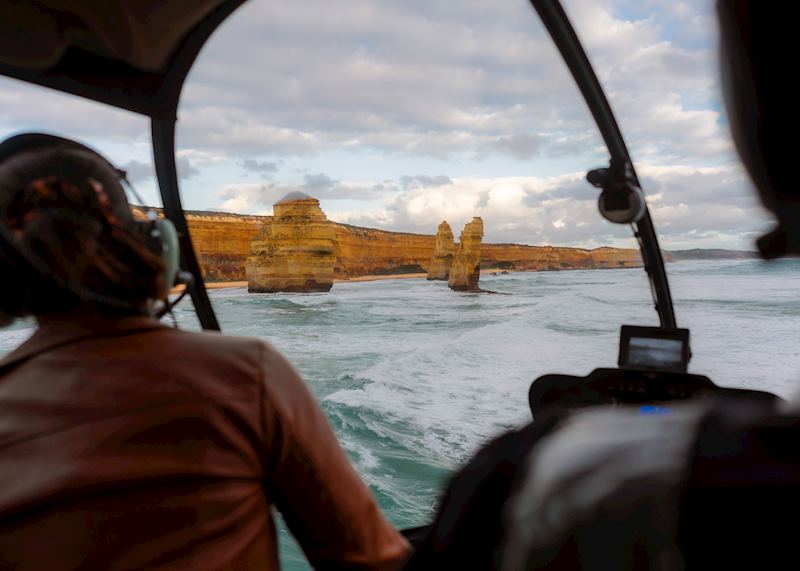
9. Hiking trails & rock art in the Grampians
Speckled sandstone and granite outcrops that stand starkly amid pancake-flat plains, the Grampians are, in my opinion, where the beauty of the Victoria countryside truly shines.
Hiking is a major pastime here, and, to me, there are several hiking trails that are a cut above the rest. I’m particularly fond of the Wonderland Loop to the Pinnacle — a knobbly cliff’s edge with panoramic views over a gum tree-carpeted valley. Although, for something gentler, the vistas from the jaw-like Balconies are equally rewarding, especially at sunset.
Everyone raves about Mackenzie Falls — and rightly so. The powerful waterfall breaks into ribbons of smaller cascades before plunging into the Mackenzie River. But the hiking spot can get very busy, particularly during summer. As an alternative, wander the trail to (and even take a dip in) the naturally formed rockpools at Venus Baths. You might also consider Boroka Lookout for a touch of stargazing beneath a freckle-faced Milky Way.
Aside from hiking, Grampians National Park is celebrated for its Indigenous rock art. This is the traditional land of the Jardwadjali and Djab Wurrung people, and on a guided walking tour from Brambuk Cultural Centre you can visit and learn about significant rock art sites like Bunjil’s Shelter.
For a base at the Grampians, the go-to location is Halls Gap, though other towns like Dunkeld and Beaufort are nearby. The outskirts of Halls Gap offer excellent opportunities for some wildlife spotting. I’ve had clients see emus, kangaroos, wallabies, and lots of yellow-crested cockatoos. My biggest tip: wait for dusk for the best sights.

10. Paddle steamers & pink lakes in Murray River
While Murray River might be one of the more far-flung regions of Victoria, I believe its offerings are just as valuable. A trove of pristine bushland, pink lakes, Victorian-era townscapes, and a river brimming with fish, it represents a simpler, sunnier, and more laidback side to the state.
Mildura is the largest “city” (it’s definitely more town sized), and it has gained a reputation for its cutting-edge food scene. The most lusted-over spot is Stefano’s, an upscale Italian restaurant owned by celebrity chef Stefano de Pieri. But there’s plenty more tasty places, as well as breweries and wineries, for you to choose from, many with passionate farm-to-table philosophies. In fact, locals call Mildura “Victoria’s food bowl” for just how much is produced here.
Then, there’s Echuca with its well-preserved 19th-century port. The main attraction here is the historic paddle steamers, which you can cruise on at a snail’s pace while taking in the dense bushland surrounding.
Venturing further into the bush, you can see powder-pink waters at Lake Hardy and Lake Crosbie. Or, you might wish to go fishing on Murray River itself — it’s well regarded for its enormous Murray cod.
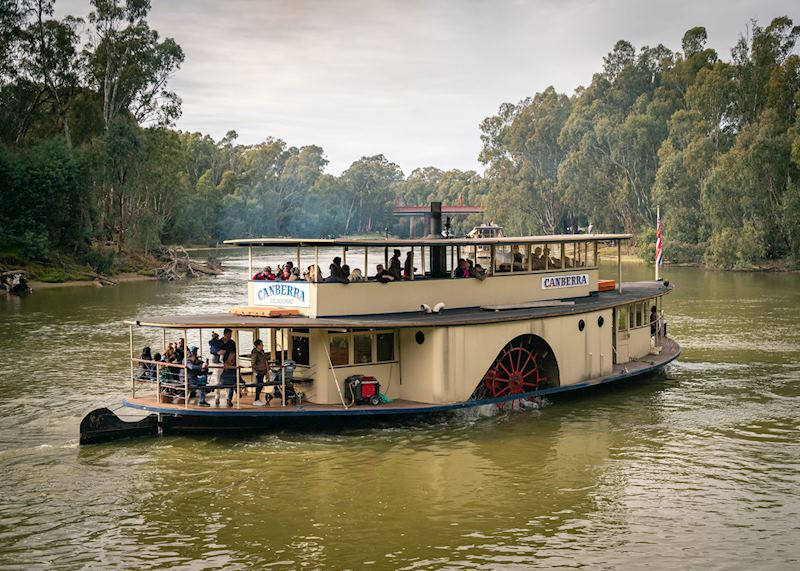
Eastern Victoria
By Australia specialist Charlotte
11. Little penguin encounters on Phillip Island
Phillip Island is a special place. It’s famed for its nightly “penguin parade”, when thousands of little penguins (the smallest penguins in the world) waddle onto its shores at sunset. You’ve got a number of ways you can experience this phenomenon — from going it alone to regimented group trips — but for me, there’s no better approach than a private tour with an expert.
Leaving from Melbourne, you first visit the adjacent French Island to explore its gnarly woodlands by 4x4 in search of koalas, kangaroos, and maybe even a few scurrying bandicoots. On my tour, we also had lunch with a local with a serving of island-made beers and wines.
Then it’s off to Phillip Island. Though it’s best known for its penguins, there’s more to do and see here. There are excellent surf beaches like Woolamai and Berrys Beach, a chocolate factory and wineries, and motorbike enthusiasts will recognise the island as the site of the Australian Motorcycle Grand Prix.
All these will keep you entertained until the highlight event at twilight. It’s a memory I hold dear. As part of the private tour, we were ushered into a small viewing area away from the crowds on the main stands, all of us hushed in excitement.
After a while, these tiny penguins started to emerge. There were hundreds of them and some of them barely a whisker away, all wobbling determinedly to their nests for the night. As we watched, our guide told us all a bit about the event, and we were given binoculars to look out further.
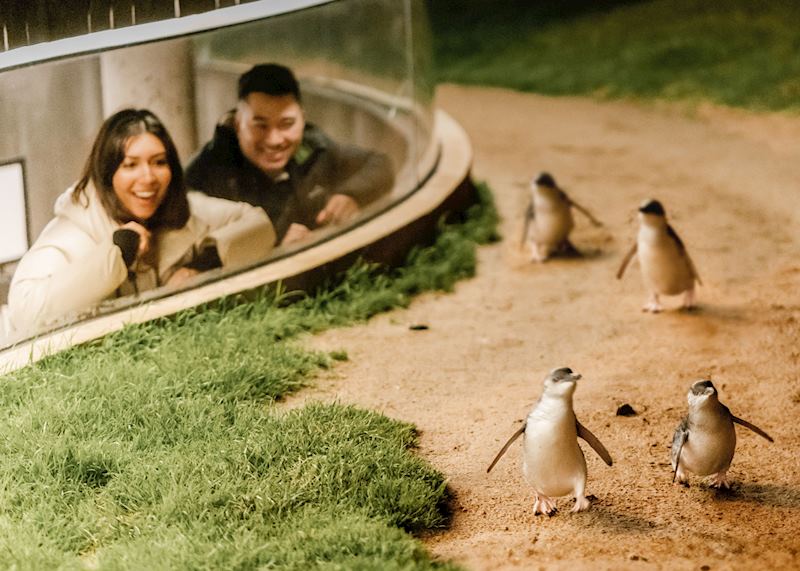
12. Squeaky beaches & marine life in Wilsons Promontory
Wilsons Promontory — or “the Prom” as Victorians call it — is a peninsula at the Australian mainland’s most southern tip. It’s one of the state’s more prominent landmarks, and people flock here year-round for its dramatic coastlines, pristine beaches, and marine life-rich waters.
What astounds me most about the region is the sheer abundance of hikes to be had. Each is a world unto itself, with possibilities to spot wildlife from wallabies to quill-covered echidnas. For the best views on a day trip, you can amble up the popular Mount Oberon Summit Walk, which overlooks sparkling turquoise sea and lily-white beaches. I’ve also got a soft spot for the Lilly Pilly Gully Nature Walk, where you can meander through eucalyptus canopies and listen out for the many whistling rainforest birds which thrive in the area.
Beach-wise, you can’t get much better either. The crème de la crème is the aptly named Squeaky Beach, a bay of powdery white quartz sands which very softly squeak when you walk on them. Although, there’s plenty other beaches where you can luxuriate, too. I like Whisky Beach for a secluded spot to watch the bright-orange sunset.
Step off the sands and onto a sea-bound cruise for some of the Prom’s best wildlife encounters. On a half-day tour with onboard naturalists, you’ll enter Wilsons Promontory Marine National Park to look out for lounging fur seal colonies, swooping white-bellied sea eagles, and (from May to July and September to December) migrating dolphins and whales.

13. Wilder terrains in Gippsland
Encompassing sprawling saltwater lagoons, a sepia-toned ghost town, sky-scraping granite escarpments, and ancient forests where Australia’s rarest wildlife dwell, Gippsland, on Victoria’s eastern flank, boasts the state’s least-tamed landscapes and territories.
I’m mesmerised most by the town of Walhalla, a once thriving gold-mining community that time eventually forgot. Though population numbers are now in the tens, the veranda-lined main street has been immaculately preserved, and you can learn more about its history at Walhalla Historical Museum or Long Tunnel Extended Gold Mine.
A drive east takes you to Ninety Mile Beach, an uninterrupted stretch of unspoiled sands (the longest in Australia). It’s the location of the Gippsland Lakes, which are in fact not lakes at all, but a network of saltwater lagoons separated from the sea by island-like sandbars.
The lakes make for a great place for water-based activities, from houseboating to waterskiing, and you can journey across Lake King to reach Raymond Island, which has one of the largest koala populations in the country. Postcard-pretty towns like Metung and Lakes Entrance are an ideal base for exploring too.
If you want to venture off-grid though, I advise you to head further east to Errinundra National Park. This temperate rainforest, thick with mossy old-growth forests and studded with granite tablelands, is as wild as you get. And it’s one of the few places where you might see a rare long-nosed potoroo.

14. Adventure in the High Country
Victoria’s High Country is best known for its skiing (yes, there’s skiing in Australia), but I’d like to wax lyrical about its other, lesser-appreciated charms like the golden-stone towns, the winding roads, and the peaks that come ablaze with autumn leaves.
The best way to see the region is along the Great Alpine Road, which loops through high canopied forests, snow-capped mountains (the Victorian Alps), and picturesque highland towns. Stop en route to see the honey-hued, 19th-century main street of Beechworth, where you can visit the cell of infamous bushranger Ned Kelly.
Bright is another highlight spot, especially if you visit during autumn. The fall foliage is unlike anywhere else in Australia and every year the surrounding Buckland Valley dazzles in scarlet reds and mellow yellows. There’s also plenty of activities to get your heart pumping from the Murray to Mountains Rail Trail to world-class mountain biking.
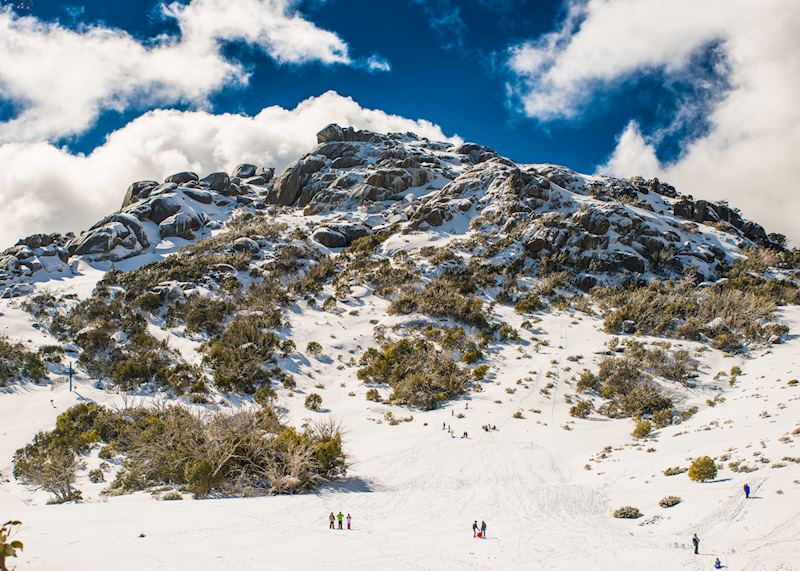
Get there with Singapore Airlines
Awarded the World's Best Airline Cabin Crew by Skytrax 2024, Singapore Airlines is dedicated to giving exceptional service to every passenger on its flights. With a highly trained crew, modern fleet, and premium in-flight entertainment, you’ll enjoy impeccable levels of comfort and customer service throughout your journey. You’ll also have a range of cabins to choose between, from Economy Class to First Class/Suites, with complimentary Wi-Fi and a wide selection of pre-booked meals available in the premium cabins.
Plus, with Singapore Airlines you can reach Victoria with ease. Fly to Singapore on one of their four flights per day from London Heathrow, and daily flights from London Gatwick, and Manchester. Then, connect seamlessly with five daily non-stop flights to Melbourne each week.
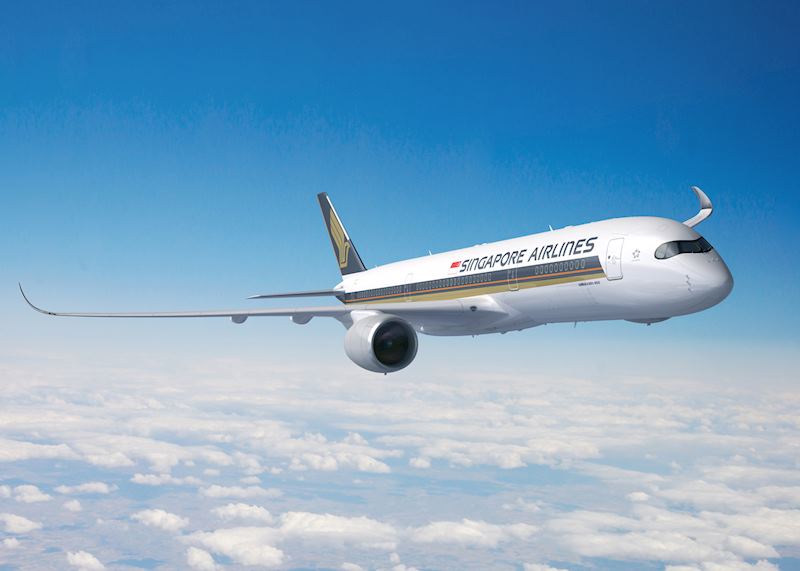
Trip ideas in Victoria
Start thinking about your experience. These itineraries are simply suggestions for how you could enjoy some of the same experiences as our specialists. They're just for inspiration, because your trip will be created around your particular tastes.
View All Tours in Australia

